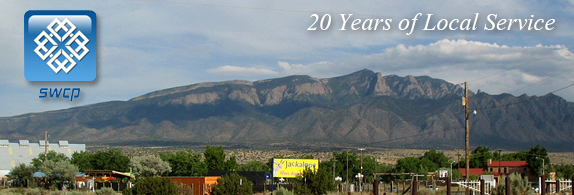Tesla Waters and Intel Vapors

New Mexico gave away the store to get Intel, the world’s largest computer chip manufacturer, to come to Rio Rancho in the l990s and now it looks like state officials are willing to do virtually anything again to get a ten million square foot (that’s about two square miles) Tesla lithium-ion battery Gigafactory to come to our state. Governor Martinez is still mulling the possibility of calling a special session of the Legislature to map an economic incentive strategy to keep the Gigafactory away from New Mexico’s competitors -- Arizona, Texas, and Nevada -- and draw it here.
Tesla and New Mexico don’t have what you’d call a winning relationship. Seven years ago, Tesla jilted New Mexico for California when the Golden State offered it a better tax package. It had already agreed to build a 150,000 square foot plant on the West Mesa and had held a press conference with Governor Bill Richardson to announce the deal. And then, blam, out the door it went heading west for a sweeter deal. But corporate persons are, of course, in it only for the money. What an insult it would be to say something like that about a real person.
Intel was lured to Rio Rancho and Sandoval County by a “public-private partnership” deal that saw the county give Intel $8 billion dollars in Industrial Revenue Bonds (IRB) in l995. At that time it was the largest IRB ever given to a company, not just in New Mexico but in the nation. (Orphaned Land p. 258) The state’s media and most of its elected leadership supported the deal. Only SWOP, the Southwest Organizing Project, and CRCAW, Corrales Residents for Clean Air and Water, had anything other than an absolute booster mentality.
SWOP, with offices in Albuquerque’s South Valley, reminded everyone that Intel’s promise to hire New Mexicans in partial exchange for the $8 billion IRB, was just so much lip service. In l997 SWOP said that only a third of the twenty five hundred hires Intel made by then had lived in New Mexico for more than a year.
That’s two thirds of the company in New Mexico who came from out of state. And to my knowledge no mainstream news media has dogged Intel on that record ever since. In fact, Intel is protected by a hands-off policy that means big media never challenges anything Intel does, or does not do because of all the jobs it has for New Mexicans!
When some 600 or more residents of Corrales who lived downwind of Intel complained of respiratory troubles, headaches, nausea, and other maladies the company and the state stonewalled them and denied any responsibility. That’s when CRCAW came into being. Although once again the mainstream media and the state dismissed their claims, even going so far as to dismiss the reality of their ailments, only Jeff Radford, editor at the Corrales Comment, reported on the growing conflict with Intel in a way that respected and took seriously residents’ accusations that Intel had made the air around its plant toxic and that living downwind from it had become a public health risk for adults and children alike. After what seemed like endless meetings and hearings, the issue was never resolved and, in fact, infects the air and the politics in Corrales to this day.
With this history one wonders what kind of deals and what kind of special treatment Tesla would be given in New Mexico. The San Jose Mercury News reports that Tesla has said it would pay $2 billion of the estimated $5 billion it would take to build the 10 million square foot Gigafactory. That’s $3 billion from us already. What about the IRBs, the myriad other breaks and loopholes and regulation deferrals that Tesla might get? And of the 6500 jobs they promise, how many of those would actually go to existing New Mexicans, not imported ringers? Tesla assures the four competing states that the 6500 jobs could well be augmented by that many suppliers of necessary goods. Tesla, incidentally, rejected California early on because of its environmental regulations, even though Californians buy more Tesla electric cars than residents of any other state.
The Los Angeles Times reports that “California pollution-control policies enable Tesla to rake in tens of millions of dollars each year from selling environmental credits to other automakers” -- a key source of Tesla’s revenue.
And then there’s the matter of location and, naturally, of water. Where in New Mexico would one put a two square mile Gigafactory? It would have to be near an interstate and, be to cynical but realistic, in an area with disenfranchised people who wouldn’t have the clout to effectively watchdog construction and operations, and somewhere with quite a bit of underground water. That’s seems to suggest somewhere on the West Mesa around Albuquerque. It can’t be too close to Intel, so it would probably have to go south of the Interstate near the South Valley with all of its polluted water.
And how much water would a 10 million square foot Gigafactory that produces lithium-ion rechargeable car batteries actually use? I think the only people who know the answer to that, at the moment, are Tesla’s executives.
We can get a glimpse into the possibilities, though, by examining how lithium-ion batteries are made. This is no easy task as it’s largely proprietary information. But we can see, from TechNewsDaily, should technological innovations become production line worthy, water might be a major component of those batteries.
Currently the charge in the batteries moves though a chemical solvent called N-methylpyrrolidone or NMP which is “expensive, toxic, and generates flammable vapors. Making batteries with this solvent,” TechNews observes, “also requires expensive, explosion-proof processing equipment and costly solvent recovery and recycling systems.” But researchers at Oak Ridge National Laboratories in Tennessee are working on ways to replace NMP with, you guessed it, water. TechNews cautions that “replacing NMP with water is tricky because the slurries, or fluids containing the materials used to make the battery’s electrodes, behave in very different ways if water is employed.”
The NMP v. water issue was still a matter of scientific dispute as of last year. But clearly New Mexico legislators and the governor’s office would have to learn a great deal about Tesla’s manufacturing processes before any responsible decision could be made about spending the vast amounts of money and time it would take to successfully lure the Gigafactory to the Land of Enchantment. But I suspect they are too busy salivating to carry out any such queries.
Thinking New Mexico; SWCP is Twenty Years Old

Many readers of the Mercury, if they had their druthers, would spend their money with local businesses rather than with national chains, franchises and suppliers. Local means, among other things, that our money tends to stay where we live, supporting our neighbors and increasing our local employment, benefitting everyone here with goods and services to sell. Local also means one probably has a chance to build personal relationships with workers and the owners of the businesses one frequents. And that ensures better service and a civil, perhaps even enjoyable, consumer experience.
This week two pieces of local business news appeared side by side in the mailbox. One a publication from Think New Mexico about the “jobs crisis” and the other from Southwest Cyberport, a local Internet service provider that’s celebrating twenty years in business.
Think New Mexico bases its analysis of the state’s job crisis on its estimate that over 3,000 businesses and 43,000 jobs “vanished from New Mexico” between 2007 and 2011.
Southwest Cyberport (SWCP) is not one of those businesses. It is an actual local company that employs local people and serves local clients with an excellent product at good prices and cordial service. I know because I’ve been a client of theirs for at least 16 of those twenty years, a client that knows next to nothing about the internet or computers or Wi-Fi that I use every day of my life. My interaction with SWCP is usually over the phone in some moment of crisis. I’m flustered. But the tech support person on the other end of the line is not flustered at all. Even with my fumbling, my wrong use of terminology, my sense of frustrated urgency, they manage to walk me though the procedures I need to get back up and running. They’ve even de-virused my machine a couple of times. New Mexico’s economy needs SWCP and all the other locally owned and entrepreneurial companies in the state – all the restaurants, bookstores, markets, arborists, papers and pens stores, all the artists, writers, musicians, and other creative people who operate as small businesses, all the small clothiers, all the galleries, the little news outlets, the electronic media. They don’t need the services that big corporations need, they need the tax breaks and incentives that big corporations get all the time.
Think New Mexico’s ideas for starting to solve the job’s crisis are imaginative and subtle. They include attracting more entrepreneurs by creating a scholarship that allows international technology, science, and business students to get instate tuition. “Research has shown that international students improve the language skills, cross- cultural fluency, and quantitative performance of local students, and they are statistically more likely to start the new businesses that will employ their classmates.”
Think New Mexico advocates reducing “the administrative burdens on businesses by creating a one-stop business portal for all fees and filings.” This is a nice idea, but if the state can’t run its own taxation and revenue department with some efficiency, how can it organize several agencies into one? But, then again, we shouldn’t shut down all thought of finding a way to accomplish more than we suppose.
Think New Mexico’s best idea, from my perspective, is to “establish a post-performance incentive that offers businesses a rebate of up to 30% of the new tax revenue they produce when they relocate to or expand operations in New Mexico – but only after new jobs and new state revenues have been created.”
Anyone who has run a small business knows how devilishly hard it can be. Just as small-time savers have had no income or growth from their accounts owning to low interest rates enforced by big moneyed gamblers in the stock market, so have small business been thwarted by complicated tax codes, bureaucratic fiddle faddle and rude officials who fawn over big corporations that promise jobs and then turn their backs on the small guys who actually make them.
You’ve got to take your hat off to small, visionary companies like SWCP. It started business against international giants at the beginning of the internet revolution. By producing a consistently great product without a lot of giveaways and incentives from government, if any at all, it has not only survived but prospered. Some big companies exploit small localities like ours and make a killing while knocking off the local competition. Some small companies serve a small locality like ours and make a good living while improving the business climate all around. Happy Birthday SWCP, and many more.
Ruben Cobos – 1911 – 2010

When I took Spanish from Dr. Ruben Cobos at the University of New Mexico in the late l950’s, I used to hide in a back row seat behind a big football player hoping against hope that Dr. Cobos wouldn’t call on me to conjugate some verb or read some passage in my hideously mispronounced Spanish. I thought at the time he was the most intimidating presence I had ever met in a classroom, even though he was a man with indefatigable charm, good spirit, and sense of humor. While I know he must have found my Spanish laughable, he never made fun of me, and in the end I wanted so badly to impress him that I learned quite a lot for a chronic “C” student, though ardent lover, of the language and its writers.
When Ruben Cobos died in November 2010, he was 99 years and eleven days old, according to his obituary. And what a life he had. Coming to New Mexico with his mother when he was 7 from Coahuila, Mexico, Cobos worked his way through Menaul School and then eyed UNM with hardly a dime in his pocket. With moxie, he went directly to then President James Zimmerman who gave him full tuition in exchange for being a hard working janitor. He eventually earned a Master’s Degree in Spanish at UNM and went on to get his doctorate at Stanford. He taught at UNM from 1936 to 1976.
Dr. Cobos spent his life teaching and researching the unique Spanish dialect of Northern New Mexico and Southern Colorado, as well as assembling a vast collection of Indo-Hispanic folklore which he started gathering in the early l940s.
The Ruben Cobos Collection of Spanish New Mexican Folklore is an archive of audio recordings “on magnetic tape” made between l944 and l974 of personal interviews and examples of “corridos and inditas (local ballads), children’s games and songs, folktales, chistes (anecdotes), jokes, home remedies, recipes, narratives dealing with local events, proverbs, riddles, songs, versos (rhymed quatrains) and witch stories and accounts of witchcraft. “These materials gave me the majority of terms,” Dr. Cobos wrote.
As a lexicographer, Dr. Cobos’ great contribution is his A Dictionary of New Mexico and Southern Colorado Spanish published by the Museum of New Mexico Press. Dr. Cobos initially got interested in the Spanish of our region when he attended Menaul School. It was there, he wrote in the preface to his dictionary “that I first became acquainted with New Mexico Spanish as spoken by my classmates. Those young men came to Menaul from homes in Santa Fe, Chimayo, Espanola, El Rito, Penasco, Taos, Mora, Chama, and other towns in New Mexico, and from Antonito, Conejos, La Jara, Alamosa, Fort Garland, San Luis, Walsenburg, Trinidad, La Junta, and other towns in Colorado.” The introduction to the dictionary gives a lucid and detailed account of the beauty and astonishing adaptability of Spanish spoken in our state.
It’s hard to describe anyone’s inner qualities. Dr. Cobos radiated an attentive calm, a gracious poise that expressed a love of life and love of other people. Small of build but of enormous stature, he was dapper and jaunty in a way that inspired confidence in others, even in his lesser students like myself. He inspired a kind of serious pleasure in learning that, of course, is given wings by the comedy of the human condition. Once when Dr. Cobos was in his early 90s, old friend and historian Marc Simmons and I were giving presentations on recent books at the National Hispanic Cultural Center. When it was my turn to speak, I turned to the audience and saw in the front row Dr. Cobos, smiling the smile of true friendship in my direction. It made me glow inside. Never truly comfortable as a public speaker, I felt a sense of peace and gratitude come over me as I saw this wise cherished friend and mentor in the audience. Afterwards, we gave each other un abrazo, and he said to me something like “You know that problem you had with pronouncing v and b. I’ve solved it. I think I’ll call you Don Be’ Be’.” (That would be as in “bey bey, or bay bay. I hope Dr. Cobos is chuckling somewhere at my crude attempts to describe that sound.) I can’t remember ever laughing so happily or feeling such acceptance. He is a man truly missed.




Responses to “Provincial Matters, 3-24-2014”